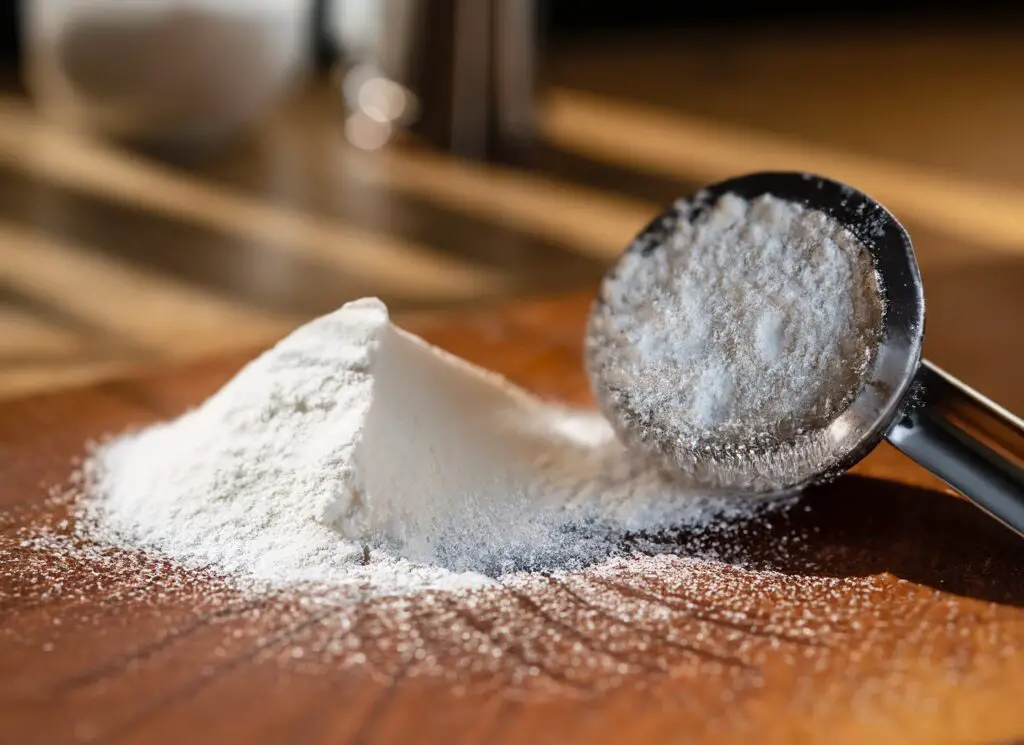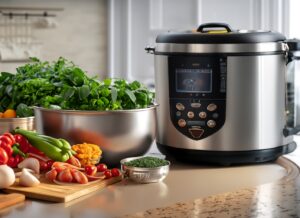Ever wondered what is the difference between baking soda and baking powder when you’re in the middle of whipping up some cookies or a cake?
You’re not alone. It’s a common dilemma for bakers and cooking enthusiasts alike, often leading to flat, dense, or overly risen baked goods.
The key difference lies in their chemical compositions and reactions. Stick around. By the end of this article, you’ll be a pro at creating light and airy cookies or chewy ones, depending on your recipe needs.
Key Facts:
(Source: Expert Team Research)
- Baking soda is pure sodium bicarbonate.
- Baking powder is a mixture of sodium bicarbonate and an acid.
- Baking soda needs an acidic ingredient to activate.
- Baking powder contains its own acid, so it doesn’t need an external one.
- Using the wrong one can ruin your baked goods.
What is the Difference Between Baking Soda and Baking Powder?
Baking soda and baking powder are both leavening agents, which means they help baked goods to rise. However, they have different chemical compositions and uses.
- Baking soda is pure sodium bicarbonate. It is a base, and it reacts with acids to produce carbon dioxide gas. This gas causes baked goods to rise. Baking soda is often used in recipes that contain acidic ingredients, such as buttermilk, yogurt, or cocoa powder.
- Baking powder is a combination of baking soda, an acid, and cornstarch. The acid in baking powder reacts with the baking soda to produce carbon dioxide gas. The cornstarch is added to prevent the baking powder from activating prematurely. Baking powder is often used in recipes that do not contain acidic ingredients, such as cookies or pancakes.
Baking Soda vs. Baking Powder: Unmasking The Crucial Differences
Here is a table summarizing the key differences between baking soda and baking powder:
| Feature | Baking soda | Baking powder |
|---|---|---|
| Chemical composition | Sodium bicarbonate | Sodium bicarbonate, an acid, and cornstarch |
| Reaction | Reacts with acids to produce carbon dioxide gas | Reacts with moisture and heat to produce carbon dioxide gas |
| When to use | Recipes that contain acidic ingredients | Recipes that do not contain acidic ingredients |
| Amount to use | Twice as much baking soda as baking powder | Twice as much baking powder as baking soda |
Chemical Compositions
Sodium Bicarbonate in Baking Soda
Baking soda is just pure sodium bicarbonate. When it meets an acid and some moisture, it reacts to form carbon dioxide bubbles. That’s what makes your dough rise.
Cream of Tartar and Cornstarch in Baking Powder
Baking powder is like the all-in-one package. It has sodium bicarbonate, but it also has an acid (usually cream of tartar) and cornstarch. The cornstarch keeps things from getting messy before it’s time.
How They React with Acid
Baking Soda and Acid
Baking soda needs an external acid to get the party started. Think buttermilk, yogurt, or even chocolate.
Baking Powder and Acid
Baking powder has its own built-in acid. So, if your recipe doesn’t have an acidic ingredient, baking powder is the go-to.
When to Use Baking Soda and Baking Powder

Recipes with Acidic Ingredients
Examples
If you’re making buttermilk pancakes or chocolate chip cookies, baking soda is your friend.
Recipes Without Acidic Ingredients
Examples
For recipes like vanilla cake or biscuits, you’ll want to stick with baking powder.
Is Baking Powder Same as Baking Soda?
No, baking powder and baking soda are not the same. They are both leavening agents, which means they help baked goods rise, but they work in different ways.
Can You Substitute Baking Soda for Baking Powder?
Yes, you can substitute baking soda for baking powder, but you need to use 3 times as much baking soda.
How to Substitute
You can, but you’ll need to triple the amount of baking soda. And don’t forget to add an acid.
Practical Examples
If your recipe calls for 1 teaspoon of baking powder, you can use 1 teaspoon of baking soda plus 2 teaspoons of cream of tartar.
Is Baking Soda Same as Baking Powder?
No, baking soda and baking powder are not the same. They are both leavening agents, which means they help baked goods rise, but they work in different ways.
Can You Substitute Baking Powder for Baking Soda?
No, you cannot substitute baking powder for baking soda without making other changes to the recipe.
Why It’s Not Recommended
Don’t try this at home, folks. Baking powder isn’t as strong, and it has that extra acid you might not want.
Chemical Reactions
You’ll end up with a different texture and probably a slightly metallic taste. Yuck.
Side Effects of Using Baking Soda and Baking Powder
Health Considerations
Both are safe, but if you’re watching your sodium, consult a doc before going overboard.
Consult Your Doctor
Especially if you have conditions like high blood pressure.
Tips for Using Baking Soda and Baking Powder
Here are some tips for using baking soda and baking powder:
- Use the right amount. Baking soda is more powerful than baking powder, so you need to use less of it. For example, if a recipe calls for 1 teaspoon of baking powder, you would only need 1/2 teaspoon of baking soda.
- Store them properly. Baking powder loses its potency over time, so it is important to store it in an airtight container in a cool, dry place.
- Don’t mix them together. Baking soda and baking powder should not be mixed together before adding them to a recipe. Mixing them together can cause them to react prematurely and your baked goods will not rise properly.
- Don’t add too much liquid. Too much liquid can dilute the baking soda or baking powder and prevent them from working properly.
- Don’t overmix. Overmixing can also deflate the baked goods and prevent them from rising properly.
- Test the baking soda. If you are not sure if your baking soda is still good, you can test it by adding a small amount to a bowl of vinegar. If it fizzes, then it is still good.
Measuring Accurately
Accuracy is key. Too much of either can lead to a culinary disaster.
Bitter or Salty Outcomes
Ever had a cookie that tasted more like the ocean? Probably too much baking soda.
Storage Tips
Keep them in a cool, dry place. Moisture is their enemy.
Effects of Moisture and Heat
They’ll lose their potency, and you’ll lose your patience.
FAQs About What is the Difference Between Baking Soda and Baking Powder
Can I use baking soda in place of baking powder?
Yes, but you’ll need to add an acid and use more of it.
Do baking powder and baking soda do the same thing?
Not exactly. They both help your baked goods rise but in different ways and under different conditions.
What is the purpose of baking soda?
Baking soda is used to help doughs and batters rise when mixed with acid.
What’s the purpose of baking powder?
Baking powder is used to help doughs and batters rise without the need for an additional acid.
Summary
In a nutshell, understanding what is the difference between baking soda and baking powder is crucial for successful baking. Baking soda is pure sodium bicarbonate and needs an acid to activate, while baking powder comes with its own acid. So, ready to bake like a pro? Keep these tips in mind, and you’ll never have a flat or metallic-tasting cookie again. Happy baking!




